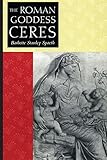The Roman Goddess Ceres / Barbette Stanley Spaeth.
Material type: TextPublisher: Austin : University of Texas Press, [2021]Copyright date: ©1995Description: 1 online resource (308 p.)Content type:
TextPublisher: Austin : University of Texas Press, [2021]Copyright date: ©1995Description: 1 online resource (308 p.)Content type: - 9780292762831
- 292.2/114 22
- BL820.C5 S63 1996eb
- online - DeGruyter
| Item type | Current library | Call number | URL | Status | Notes | Barcode | |
|---|---|---|---|---|---|---|---|
 eBook
eBook
|
Biblioteca "Angelicum" Pont. Univ. S.Tommaso d'Aquino Nuvola online | online - DeGruyter (Browse shelf(Opens below)) | Online access | Not for loan (Accesso limitato) | Accesso per gli utenti autorizzati / Access for authorized users | (dgr)9780292762831 |
Frontmatter -- CONTENTS -- ILLUSTRATIONS -- PREFACE -- ACKNOWLEDGMENTS -- Chapter 1 HISTORICAL OVERVIEW -- Chapter 2 FERTILITY -- Chapter 3 LIMINALITY -- Chapter 4 THE PLEBS -- Chapter 5 WOMEN -- Chapter 6 CERES IN THE ARA PACIS AUGUSTAE -- Appendix 1 ORIGINAL TEXT OF TRANSLATED PASSAGES -- Appendix 2. WOMEN OF THE IMPERIAL FAMILY IDENTIFIED WITH CERES -- NOTES -- REFERENCES -- GENERAL INDEX -- INDEX OF PASSAGES CITED
restricted access online access with authorization star
http://purl.org/coar/access_right/c_16ec
Interest in goddess worship is growing in contemporary society, as women seek models for feminine spirituality and wholeness. New cults are developing around ancient goddesses from many cultures, although their modern adherents often envision and interpret the goddesses very differently than their original worshippers did. In this thematic study of the Roman goddess Ceres, Barbette Spaeth explores the rich complexity of meanings and functions that grew up around the goddess from the prehistoric period to the Late Roman Empire. In particular, she examines two major concepts, fertility and liminality, and two social categories, the plebs and women, which were inextricably linked with Ceres in the Roman mind. Spaeth then analyzes an image of the goddess in a relief of the Ara Pacis, an important state monument of the Augustan period, showing how it incorporates all these varied roles and associations of Ceres. This interpretation represents a new contribution to art history. With its use of literary, epigraphical, numismatic, artistic, and archaeological evidence, The Roman Goddess Ceres presents a more encompassing view of the goddess than was previously available. It will be important reading for all students of Classics, as well as for a general audience interested in New Age, feminist, or pagan spirituality.
Mode of access: Internet via World Wide Web.
In English.
Description based on online resource; title from PDF title page (publisher's Web site, viewed 26. Apr 2022)


